NEU BTEC HND: Leadership and Management at Samsung Vietnam
VerifiedAdded on 2021/05/25
|19
|7364
|387
Report
AI Summary
This report analyzes leadership and management practices at Samsung Electronics Vietnam, focusing on the roles of leaders and managers within the organization. The scenario describes Samsung's growth, its operations in Vietnam, and the challenges faced by a Public Relations Manager, Ms. Ngoc. The report requires differentiating between leadership and management, defining their roles, and comparing them. It further necessitates applying these roles in the context of Samsung Vietnam, specifically addressing Ms. Ngoc's challenges related to financial constraints, communication platforms, manpower, and social media usage. The report will likely explore leadership styles, management functions, and strategies for effective public relations within the company's framework, providing recommendations to improve the current practices. The report aims to provide a comprehensive understanding of leadership and management principles within a real-world business setting.
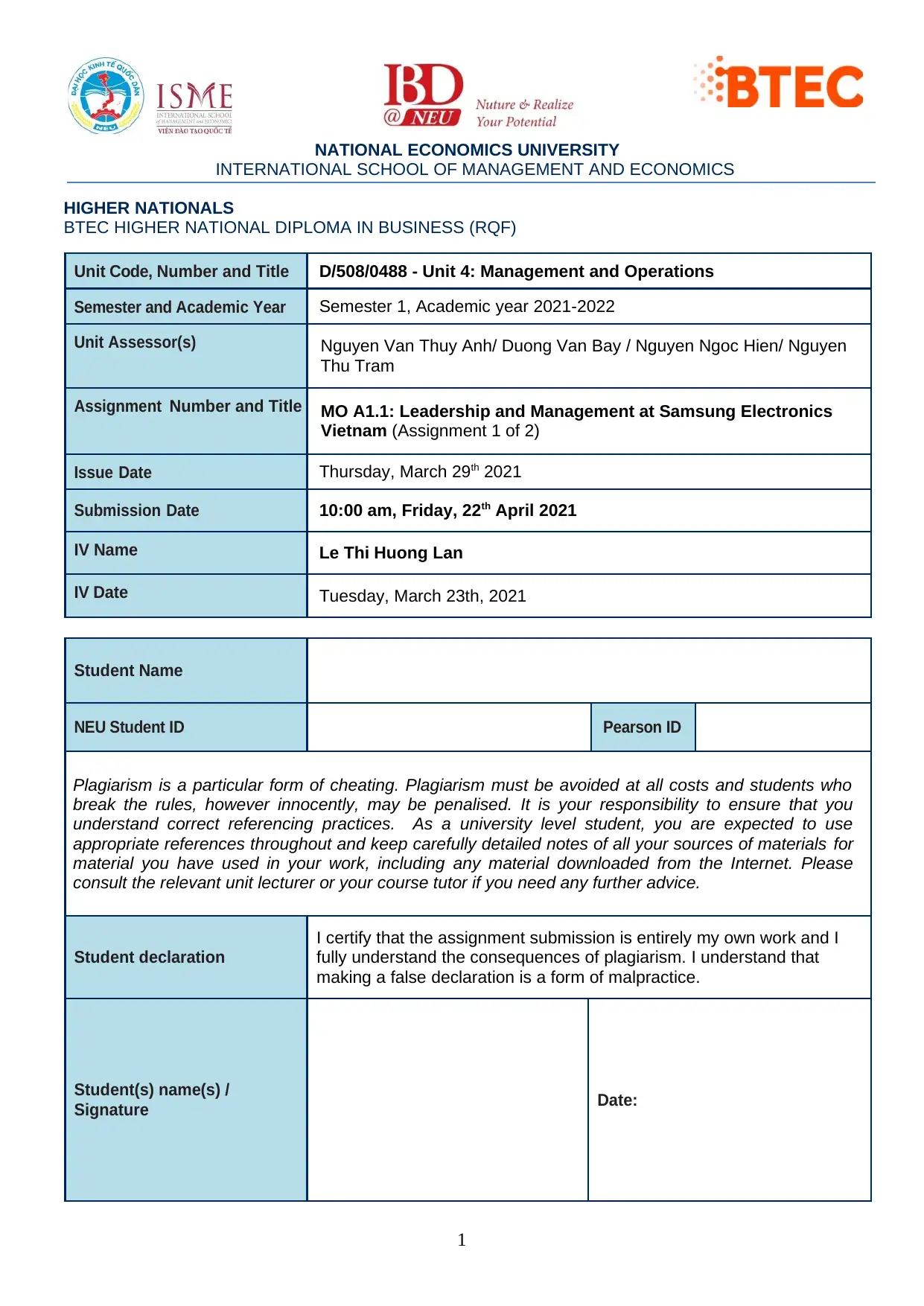
NATIONAL ECONOMICS UNIVERSITY
INTERNATIONAL SCHOOL OF MANAGEMENT AND ECONOMICS
HIGHER NATIONALS
BTEC HIGHER NATIONAL DIPLOMA IN BUSINESS (RQF)
Unit Code, Number and Title D/508/0488 - Unit 4: Management and Operations
Semester and Academic Year Semester 1, Academic year 2021-2022
Unit Assessor(s) Nguyen Van Thuy Anh/ Duong Van Bay / Nguyen Ngoc Hien/ Nguyen
Thu Tram
Assignment Number and Title MO A1.1: Leadership and Management at Samsung Electronics
Vietnam (Assignment 1 of 2)
Issue Date Thursday, March 29th 2021
Submission Date 10:00 am, Friday, 22th April 2021
IV Name Le Thi Huong Lan
IV Date Tuesday, March 23th, 2021
Student Name
NEU Student ID Pearson ID
Plagiarism is a particular form of cheating. Plagiarism must be avoided at all costs and students who
break the rules, however innocently, may be penalised. It is your responsibility to ensure that you
understand correct referencing practices. As a university level student, you are expected to use
appropriate references throughout and keep carefully detailed notes of all your sources of materials for
material you have used in your work, including any material downloaded from the Internet. Please
consult the relevant unit lecturer or your course tutor if you need any further advice.
Student declaration
I certify that the assignment submission is entirely my own work and I
fully understand the consequences of plagiarism. I understand that
making a false declaration is a form of malpractice.
Student(s) name(s) /
Signature Date:
1
INTERNATIONAL SCHOOL OF MANAGEMENT AND ECONOMICS
HIGHER NATIONALS
BTEC HIGHER NATIONAL DIPLOMA IN BUSINESS (RQF)
Unit Code, Number and Title D/508/0488 - Unit 4: Management and Operations
Semester and Academic Year Semester 1, Academic year 2021-2022
Unit Assessor(s) Nguyen Van Thuy Anh/ Duong Van Bay / Nguyen Ngoc Hien/ Nguyen
Thu Tram
Assignment Number and Title MO A1.1: Leadership and Management at Samsung Electronics
Vietnam (Assignment 1 of 2)
Issue Date Thursday, March 29th 2021
Submission Date 10:00 am, Friday, 22th April 2021
IV Name Le Thi Huong Lan
IV Date Tuesday, March 23th, 2021
Student Name
NEU Student ID Pearson ID
Plagiarism is a particular form of cheating. Plagiarism must be avoided at all costs and students who
break the rules, however innocently, may be penalised. It is your responsibility to ensure that you
understand correct referencing practices. As a university level student, you are expected to use
appropriate references throughout and keep carefully detailed notes of all your sources of materials for
material you have used in your work, including any material downloaded from the Internet. Please
consult the relevant unit lecturer or your course tutor if you need any further advice.
Student declaration
I certify that the assignment submission is entirely my own work and I
fully understand the consequences of plagiarism. I understand that
making a false declaration is a form of malpractice.
Student(s) name(s) /
Signature Date:
1
Paraphrase This Document
Need a fresh take? Get an instant paraphrase of this document with our AI Paraphraser
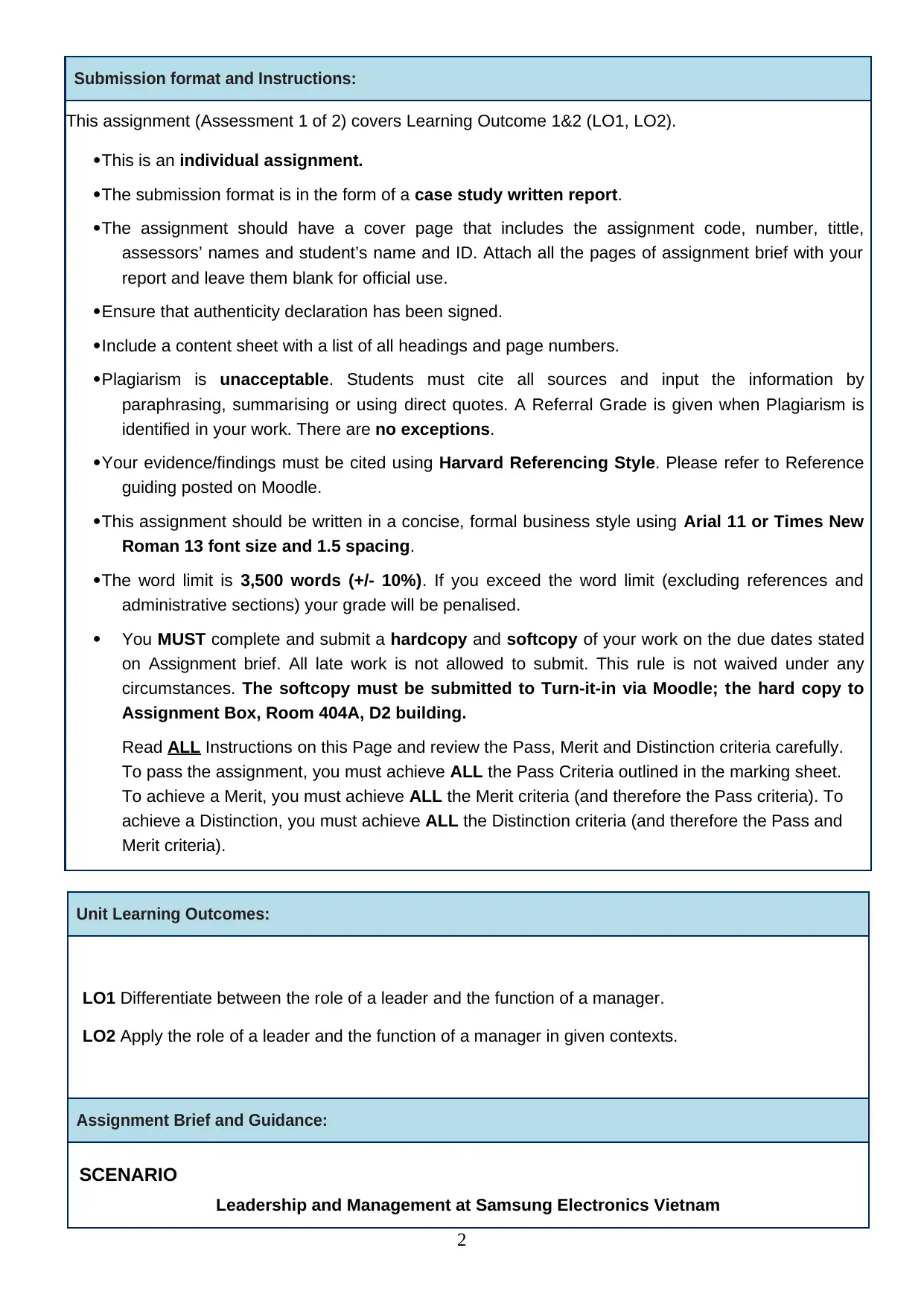
Submission format and Instructions:
This assignment (Assessment 1 of 2) covers Learning Outcome 1&2 (LO1, LO2).
This is an individual assignment.
The submission format is in the form of a case study written report.
The assignment should have a cover page that includes the assignment code, number, tittle,
assessors’ names and student’s name and ID. Attach all the pages of assignment brief with your
report and leave them blank for official use.
Ensure that authenticity declaration has been signed.
Include a content sheet with a list of all headings and page numbers.
Plagiarism is unacceptable. Students must cite all sources and input the information by
paraphrasing, summarising or using direct quotes. A Referral Grade is given when Plagiarism is
identified in your work. There are no exceptions.
Your evidence/findings must be cited using Harvard Referencing Style. Please refer to Reference
guiding posted on Moodle.
This assignment should be written in a concise, formal business style using Arial 11 or Times New
Roman 13 font size and 1.5 spacing.
The word limit is 3,500 words (+/- 10%). If you exceed the word limit (excluding references and
administrative sections) your grade will be penalised.
You MUST complete and submit a hardcopy and softcopy of your work on the due dates stated
on Assignment brief. All late work is not allowed to submit. This rule is not waived under any
circumstances. The softcopy must be submitted to Turn-it-in via Moodle; the hard copy to
Assignment Box, Room 404A, D2 building.
Read ALL Instructions on this Page and review the Pass, Merit and Distinction criteria carefully.
To pass the assignment, you must achieve ALL the Pass Criteria outlined in the marking sheet.
To achieve a Merit, you must achieve ALL the Merit criteria (and therefore the Pass criteria). To
achieve a Distinction, you must achieve ALL the Distinction criteria (and therefore the Pass and
Merit criteria).
Unit Learning Outcomes:
LO1 Differentiate between the role of a leader and the function of a manager.
LO2 Apply the role of a leader and the function of a manager in given contexts.
Assignment Brief and Guidance:
SCENARIO
Leadership and Management at Samsung Electronics Vietnam
2
This assignment (Assessment 1 of 2) covers Learning Outcome 1&2 (LO1, LO2).
This is an individual assignment.
The submission format is in the form of a case study written report.
The assignment should have a cover page that includes the assignment code, number, tittle,
assessors’ names and student’s name and ID. Attach all the pages of assignment brief with your
report and leave them blank for official use.
Ensure that authenticity declaration has been signed.
Include a content sheet with a list of all headings and page numbers.
Plagiarism is unacceptable. Students must cite all sources and input the information by
paraphrasing, summarising or using direct quotes. A Referral Grade is given when Plagiarism is
identified in your work. There are no exceptions.
Your evidence/findings must be cited using Harvard Referencing Style. Please refer to Reference
guiding posted on Moodle.
This assignment should be written in a concise, formal business style using Arial 11 or Times New
Roman 13 font size and 1.5 spacing.
The word limit is 3,500 words (+/- 10%). If you exceed the word limit (excluding references and
administrative sections) your grade will be penalised.
You MUST complete and submit a hardcopy and softcopy of your work on the due dates stated
on Assignment brief. All late work is not allowed to submit. This rule is not waived under any
circumstances. The softcopy must be submitted to Turn-it-in via Moodle; the hard copy to
Assignment Box, Room 404A, D2 building.
Read ALL Instructions on this Page and review the Pass, Merit and Distinction criteria carefully.
To pass the assignment, you must achieve ALL the Pass Criteria outlined in the marking sheet.
To achieve a Merit, you must achieve ALL the Merit criteria (and therefore the Pass criteria). To
achieve a Distinction, you must achieve ALL the Distinction criteria (and therefore the Pass and
Merit criteria).
Unit Learning Outcomes:
LO1 Differentiate between the role of a leader and the function of a manager.
LO2 Apply the role of a leader and the function of a manager in given contexts.
Assignment Brief and Guidance:
SCENARIO
Leadership and Management at Samsung Electronics Vietnam
2
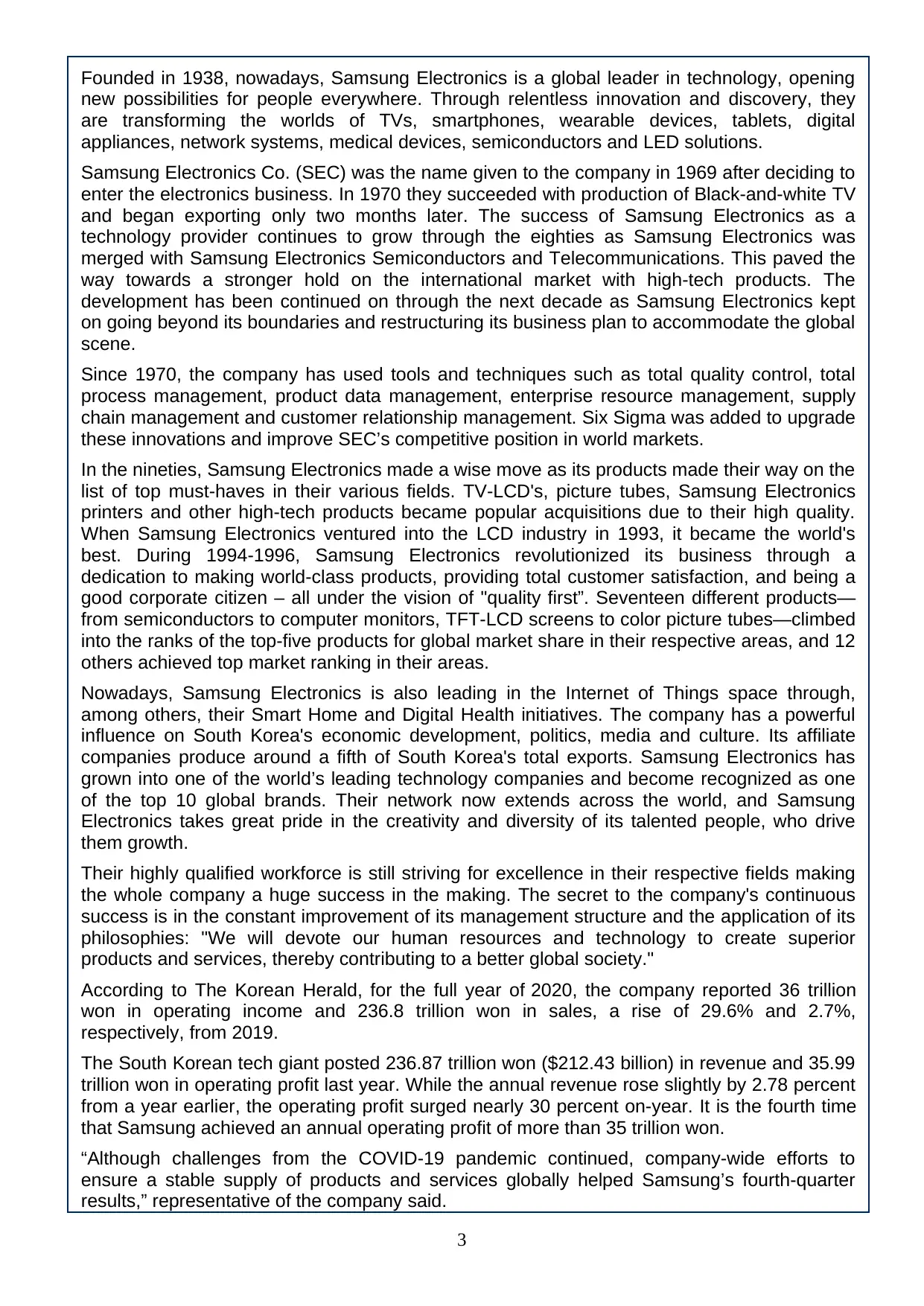
Founded in 1938, nowadays, Samsung Electronics is a global leader in technology, opening
new possibilities for people everywhere. Through relentless innovation and discovery, they
are transforming the worlds of TVs, smartphones, wearable devices, tablets, digital
appliances, network systems, medical devices, semiconductors and LED solutions.
Samsung Electronics Co. (SEC) was the name given to the company in 1969 after deciding to
enter the electronics business. In 1970 they succeeded with production of Black-and-white TV
and began exporting only two months later. The success of Samsung Electronics as a
technology provider continues to grow through the eighties as Samsung Electronics was
merged with Samsung Electronics Semiconductors and Telecommunications. This paved the
way towards a stronger hold on the international market with high-tech products. The
development has been continued on through the next decade as Samsung Electronics kept
on going beyond its boundaries and restructuring its business plan to accommodate the global
scene.
Since 1970, the company has used tools and techniques such as total quality control, total
process management, product data management, enterprise resource management, supply
chain management and customer relationship management. Six Sigma was added to upgrade
these innovations and improve SEC’s competitive position in world markets.
In the nineties, Samsung Electronics made a wise move as its products made their way on the
list of top must-haves in their various fields. TV-LCD's, picture tubes, Samsung Electronics
printers and other high-tech products became popular acquisitions due to their high quality.
When Samsung Electronics ventured into the LCD industry in 1993, it became the world's
best. During 1994-1996, Samsung Electronics revolutionized its business through a
dedication to making world-class products, providing total customer satisfaction, and being a
good corporate citizen – all under the vision of "quality first”. Seventeen different products—
from semiconductors to computer monitors, TFT-LCD screens to color picture tubes—climbed
into the ranks of the top-five products for global market share in their respective areas, and 12
others achieved top market ranking in their areas.
Nowadays, Samsung Electronics is also leading in the Internet of Things space through,
among others, their Smart Home and Digital Health initiatives. The company has a powerful
influence on South Korea's economic development, politics, media and culture. Its affiliate
companies produce around a fifth of South Korea's total exports. Samsung Electronics has
grown into one of the world’s leading technology companies and become recognized as one
of the top 10 global brands. Their network now extends across the world, and Samsung
Electronics takes great pride in the creativity and diversity of its talented people, who drive
them growth.
Their highly qualified workforce is still striving for excellence in their respective fields making
the whole company a huge success in the making. The secret to the company's continuous
success is in the constant improvement of its management structure and the application of its
philosophies: "We will devote our human resources and technology to create superior
products and services, thereby contributing to a better global society."
According to The Korean Herald, for the full year of 2020, the company reported 36 trillion
won in operating income and 236.8 trillion won in sales, a rise of 29.6% and 2.7%,
respectively, from 2019.
The South Korean tech giant posted 236.87 trillion won ($212.43 billion) in revenue and 35.99
trillion won in operating profit last year. While the annual revenue rose slightly by 2.78 percent
from a year earlier, the operating profit surged nearly 30 percent on-year. It is the fourth time
that Samsung achieved an annual operating profit of more than 35 trillion won.
“Although challenges from the COVID-19 pandemic continued, company-wide efforts to
ensure a stable supply of products and services globally helped Samsung’s fourth-quarter
results,” representative of the company said.
3
new possibilities for people everywhere. Through relentless innovation and discovery, they
are transforming the worlds of TVs, smartphones, wearable devices, tablets, digital
appliances, network systems, medical devices, semiconductors and LED solutions.
Samsung Electronics Co. (SEC) was the name given to the company in 1969 after deciding to
enter the electronics business. In 1970 they succeeded with production of Black-and-white TV
and began exporting only two months later. The success of Samsung Electronics as a
technology provider continues to grow through the eighties as Samsung Electronics was
merged with Samsung Electronics Semiconductors and Telecommunications. This paved the
way towards a stronger hold on the international market with high-tech products. The
development has been continued on through the next decade as Samsung Electronics kept
on going beyond its boundaries and restructuring its business plan to accommodate the global
scene.
Since 1970, the company has used tools and techniques such as total quality control, total
process management, product data management, enterprise resource management, supply
chain management and customer relationship management. Six Sigma was added to upgrade
these innovations and improve SEC’s competitive position in world markets.
In the nineties, Samsung Electronics made a wise move as its products made their way on the
list of top must-haves in their various fields. TV-LCD's, picture tubes, Samsung Electronics
printers and other high-tech products became popular acquisitions due to their high quality.
When Samsung Electronics ventured into the LCD industry in 1993, it became the world's
best. During 1994-1996, Samsung Electronics revolutionized its business through a
dedication to making world-class products, providing total customer satisfaction, and being a
good corporate citizen – all under the vision of "quality first”. Seventeen different products—
from semiconductors to computer monitors, TFT-LCD screens to color picture tubes—climbed
into the ranks of the top-five products for global market share in their respective areas, and 12
others achieved top market ranking in their areas.
Nowadays, Samsung Electronics is also leading in the Internet of Things space through,
among others, their Smart Home and Digital Health initiatives. The company has a powerful
influence on South Korea's economic development, politics, media and culture. Its affiliate
companies produce around a fifth of South Korea's total exports. Samsung Electronics has
grown into one of the world’s leading technology companies and become recognized as one
of the top 10 global brands. Their network now extends across the world, and Samsung
Electronics takes great pride in the creativity and diversity of its talented people, who drive
them growth.
Their highly qualified workforce is still striving for excellence in their respective fields making
the whole company a huge success in the making. The secret to the company's continuous
success is in the constant improvement of its management structure and the application of its
philosophies: "We will devote our human resources and technology to create superior
products and services, thereby contributing to a better global society."
According to The Korean Herald, for the full year of 2020, the company reported 36 trillion
won in operating income and 236.8 trillion won in sales, a rise of 29.6% and 2.7%,
respectively, from 2019.
The South Korean tech giant posted 236.87 trillion won ($212.43 billion) in revenue and 35.99
trillion won in operating profit last year. While the annual revenue rose slightly by 2.78 percent
from a year earlier, the operating profit surged nearly 30 percent on-year. It is the fourth time
that Samsung achieved an annual operating profit of more than 35 trillion won.
“Although challenges from the COVID-19 pandemic continued, company-wide efforts to
ensure a stable supply of products and services globally helped Samsung’s fourth-quarter
results,” representative of the company said.
3
⊘ This is a preview!⊘
Do you want full access?
Subscribe today to unlock all pages.

Trusted by 1+ million students worldwide
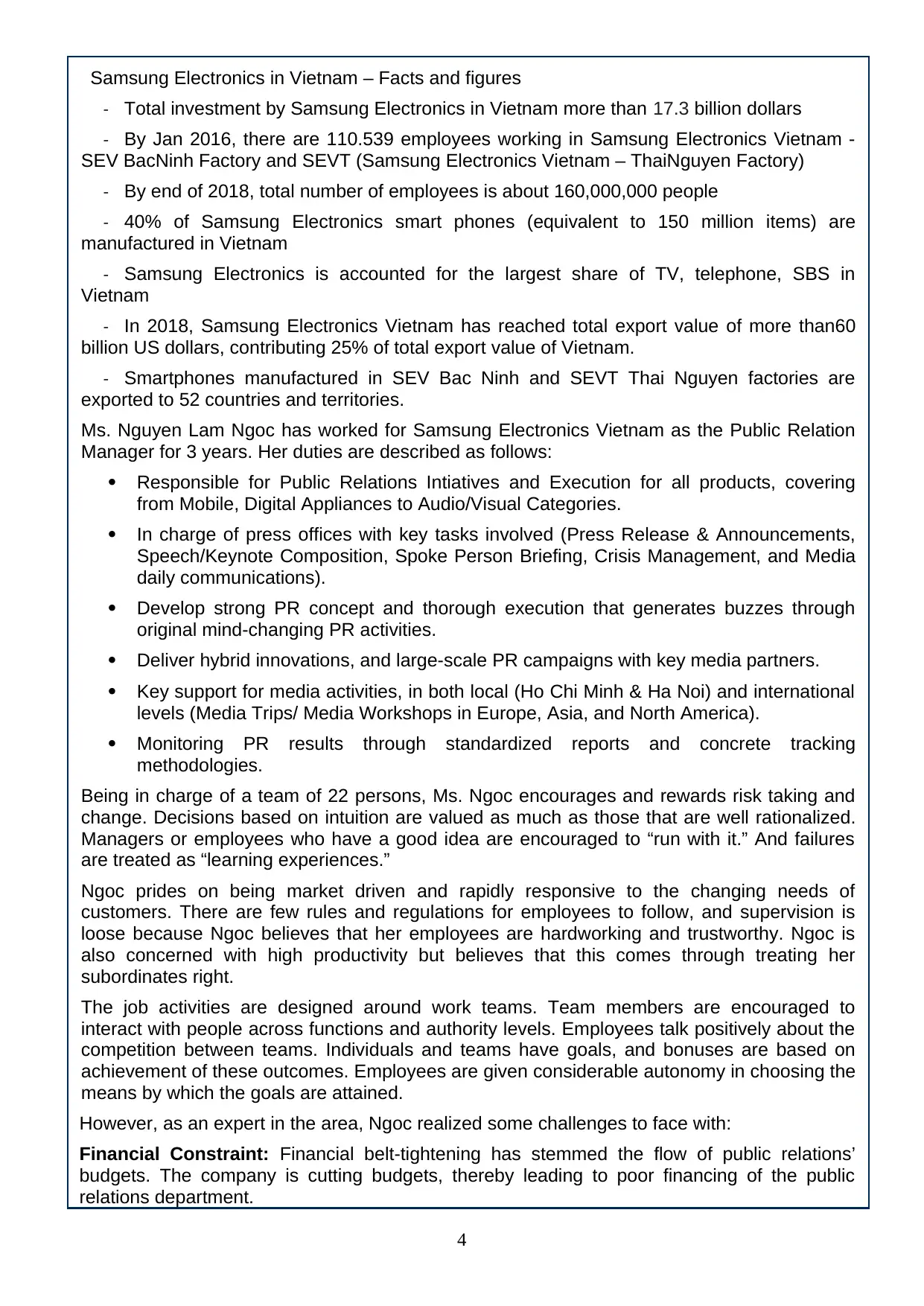
Samsung Electronics in Vietnam – Facts and figures
- Total investment by Samsung Electronics in Vietnam more than 17.3 billion dollars
- By Jan 2016, there are 110.539 employees working in Samsung Electronics Vietnam -
SEV BacNinh Factory and SEVT (Samsung Electronics Vietnam – ThaiNguyen Factory)
- By end of 2018, total number of employees is about 160,000,000 people
- 40% of Samsung Electronics smart phones (equivalent to 150 million items) are
manufactured in Vietnam
- Samsung Electronics is accounted for the largest share of TV, telephone, SBS in
Vietnam
- In 2018, Samsung Electronics Vietnam has reached total export value of more than60
billion US dollars, contributing 25% of total export value of Vietnam.
- Smartphones manufactured in SEV Bac Ninh and SEVT Thai Nguyen factories are
exported to 52 countries and territories.
Ms. Nguyen Lam Ngoc has worked for Samsung Electronics Vietnam as the Public Relation
Manager for 3 years. Her duties are described as follows:
Responsible for Public Relations Intiatives and Execution for all products, covering
from Mobile, Digital Appliances to Audio/Visual Categories.
In charge of press offices with key tasks involved (Press Release & Announcements,
Speech/Keynote Composition, Spoke Person Briefing, Crisis Management, and Media
daily communications).
Develop strong PR concept and thorough execution that generates buzzes through
original mind-changing PR activities.
Deliver hybrid innovations, and large-scale PR campaigns with key media partners.
Key support for media activities, in both local (Ho Chi Minh & Ha Noi) and international
levels (Media Trips/ Media Workshops in Europe, Asia, and North America).
Monitoring PR results through standardized reports and concrete tracking
methodologies.
Being in charge of a team of 22 persons, Ms. Ngoc encourages and rewards risk taking and
change. Decisions based on intuition are valued as much as those that are well rationalized.
Managers or employees who have a good idea are encouraged to “run with it.” And failures
are treated as “learning experiences.”
Ngoc prides on being market driven and rapidly responsive to the changing needs of
customers. There are few rules and regulations for employees to follow, and supervision is
loose because Ngoc believes that her employees are hardworking and trustworthy. Ngoc is
also concerned with high productivity but believes that this comes through treating her
subordinates right.
The job activities are designed around work teams. Team members are encouraged to
interact with people across functions and authority levels. Employees talk positively about the
competition between teams. Individuals and teams have goals, and bonuses are based on
achievement of these outcomes. Employees are given considerable autonomy in choosing the
means by which the goals are attained.
However, as an expert in the area, Ngoc realized some challenges to face with:
Financial Constraint: Financial belt-tightening has stemmed the flow of public relations’
budgets. The company is cutting budgets, thereby leading to poor financing of the public
relations department.
4
- Total investment by Samsung Electronics in Vietnam more than 17.3 billion dollars
- By Jan 2016, there are 110.539 employees working in Samsung Electronics Vietnam -
SEV BacNinh Factory and SEVT (Samsung Electronics Vietnam – ThaiNguyen Factory)
- By end of 2018, total number of employees is about 160,000,000 people
- 40% of Samsung Electronics smart phones (equivalent to 150 million items) are
manufactured in Vietnam
- Samsung Electronics is accounted for the largest share of TV, telephone, SBS in
Vietnam
- In 2018, Samsung Electronics Vietnam has reached total export value of more than60
billion US dollars, contributing 25% of total export value of Vietnam.
- Smartphones manufactured in SEV Bac Ninh and SEVT Thai Nguyen factories are
exported to 52 countries and territories.
Ms. Nguyen Lam Ngoc has worked for Samsung Electronics Vietnam as the Public Relation
Manager for 3 years. Her duties are described as follows:
Responsible for Public Relations Intiatives and Execution for all products, covering
from Mobile, Digital Appliances to Audio/Visual Categories.
In charge of press offices with key tasks involved (Press Release & Announcements,
Speech/Keynote Composition, Spoke Person Briefing, Crisis Management, and Media
daily communications).
Develop strong PR concept and thorough execution that generates buzzes through
original mind-changing PR activities.
Deliver hybrid innovations, and large-scale PR campaigns with key media partners.
Key support for media activities, in both local (Ho Chi Minh & Ha Noi) and international
levels (Media Trips/ Media Workshops in Europe, Asia, and North America).
Monitoring PR results through standardized reports and concrete tracking
methodologies.
Being in charge of a team of 22 persons, Ms. Ngoc encourages and rewards risk taking and
change. Decisions based on intuition are valued as much as those that are well rationalized.
Managers or employees who have a good idea are encouraged to “run with it.” And failures
are treated as “learning experiences.”
Ngoc prides on being market driven and rapidly responsive to the changing needs of
customers. There are few rules and regulations for employees to follow, and supervision is
loose because Ngoc believes that her employees are hardworking and trustworthy. Ngoc is
also concerned with high productivity but believes that this comes through treating her
subordinates right.
The job activities are designed around work teams. Team members are encouraged to
interact with people across functions and authority levels. Employees talk positively about the
competition between teams. Individuals and teams have goals, and bonuses are based on
achievement of these outcomes. Employees are given considerable autonomy in choosing the
means by which the goals are attained.
However, as an expert in the area, Ngoc realized some challenges to face with:
Financial Constraint: Financial belt-tightening has stemmed the flow of public relations’
budgets. The company is cutting budgets, thereby leading to poor financing of the public
relations department.
4
Paraphrase This Document
Need a fresh take? Get an instant paraphrase of this document with our AI Paraphraser
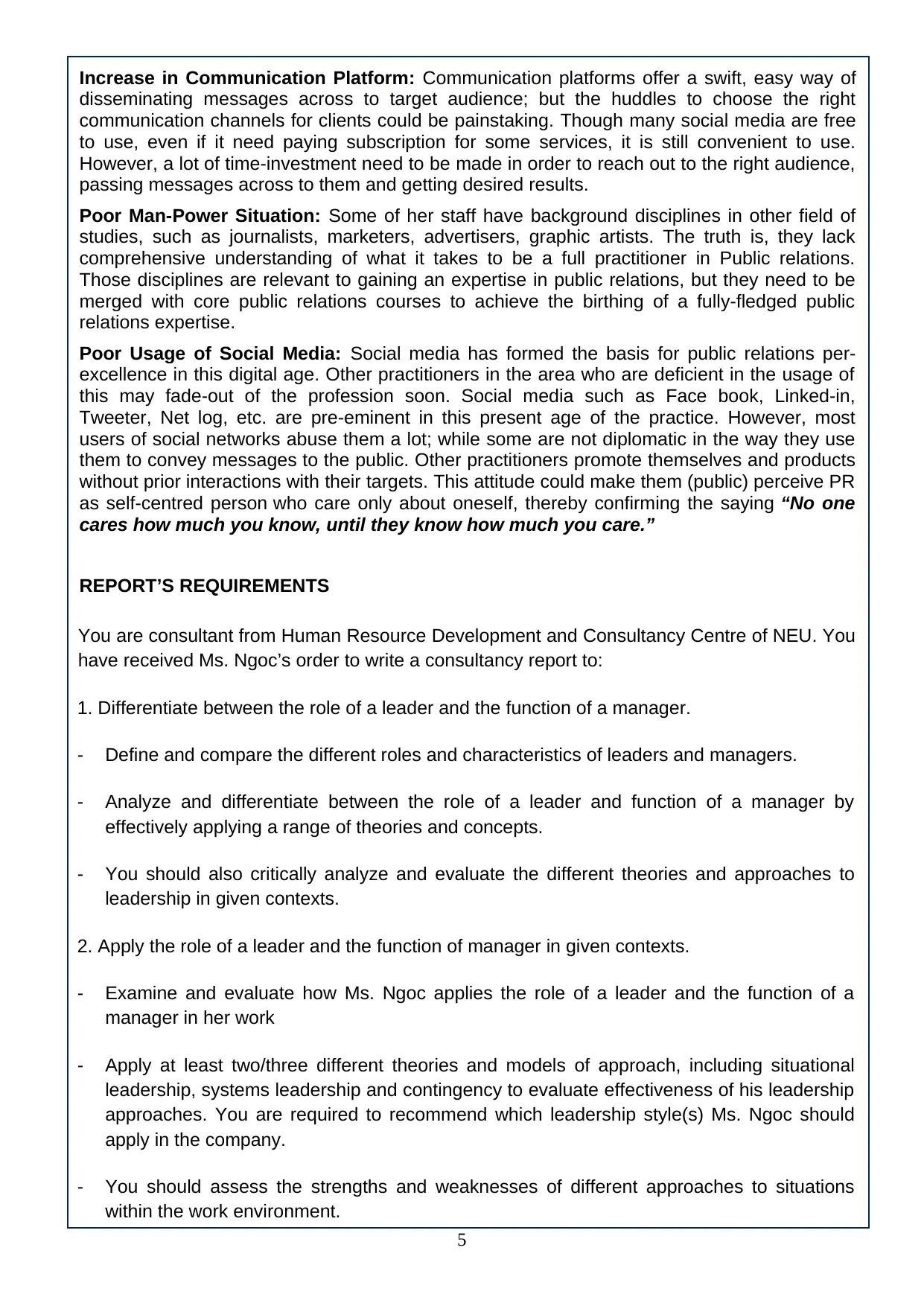
Increase in Communication Platform: Communication platforms offer a swift, easy way of
disseminating messages across to target audience; but the huddles to choose the right
communication channels for clients could be painstaking. Though many social media are free
to use, even if it need paying subscription for some services, it is still convenient to use.
However, a lot of time-investment need to be made in order to reach out to the right audience,
passing messages across to them and getting desired results.
Poor Man-Power Situation: Some of her staff have background disciplines in other field of
studies, such as journalists, marketers, advertisers, graphic artists. The truth is, they lack
comprehensive understanding of what it takes to be a full practitioner in Public relations.
Those disciplines are relevant to gaining an expertise in public relations, but they need to be
merged with core public relations courses to achieve the birthing of a fully-fledged public
relations expertise.
Poor Usage of Social Media: Social media has formed the basis for public relations per-
excellence in this digital age. Other practitioners in the area who are deficient in the usage of
this may fade-out of the profession soon. Social media such as Face book, Linked-in,
Tweeter, Net log, etc. are pre-eminent in this present age of the practice. However, most
users of social networks abuse them a lot; while some are not diplomatic in the way they use
them to convey messages to the public. Other practitioners promote themselves and products
without prior interactions with their targets. This attitude could make them (public) perceive PR
as self-centred person who care only about oneself, thereby confirming the saying “No one
cares how much you know, until they know how much you care.”
REPORT’S REQUIREMENTS
You are consultant from Human Resource Development and Consultancy Centre of NEU. You
have received Ms. Ngoc’s order to write a consultancy report to:
1. Differentiate between the role of a leader and the function of a manager.
- Define and compare the different roles and characteristics of leaders and managers.
- Analyze and differentiate between the role of a leader and function of a manager by
effectively applying a range of theories and concepts.
- You should also critically analyze and evaluate the different theories and approaches to
leadership in given contexts.
2. Apply the role of a leader and the function of manager in given contexts.
- Examine and evaluate how Ms. Ngoc applies the role of a leader and the function of a
manager in her work
- Apply at least two/three different theories and models of approach, including situational
leadership, systems leadership and contingency to evaluate effectiveness of his leadership
approaches. You are required to recommend which leadership style(s) Ms. Ngoc should
apply in the company.
- You should assess the strengths and weaknesses of different approaches to situations
within the work environment.
5
disseminating messages across to target audience; but the huddles to choose the right
communication channels for clients could be painstaking. Though many social media are free
to use, even if it need paying subscription for some services, it is still convenient to use.
However, a lot of time-investment need to be made in order to reach out to the right audience,
passing messages across to them and getting desired results.
Poor Man-Power Situation: Some of her staff have background disciplines in other field of
studies, such as journalists, marketers, advertisers, graphic artists. The truth is, they lack
comprehensive understanding of what it takes to be a full practitioner in Public relations.
Those disciplines are relevant to gaining an expertise in public relations, but they need to be
merged with core public relations courses to achieve the birthing of a fully-fledged public
relations expertise.
Poor Usage of Social Media: Social media has formed the basis for public relations per-
excellence in this digital age. Other practitioners in the area who are deficient in the usage of
this may fade-out of the profession soon. Social media such as Face book, Linked-in,
Tweeter, Net log, etc. are pre-eminent in this present age of the practice. However, most
users of social networks abuse them a lot; while some are not diplomatic in the way they use
them to convey messages to the public. Other practitioners promote themselves and products
without prior interactions with their targets. This attitude could make them (public) perceive PR
as self-centred person who care only about oneself, thereby confirming the saying “No one
cares how much you know, until they know how much you care.”
REPORT’S REQUIREMENTS
You are consultant from Human Resource Development and Consultancy Centre of NEU. You
have received Ms. Ngoc’s order to write a consultancy report to:
1. Differentiate between the role of a leader and the function of a manager.
- Define and compare the different roles and characteristics of leaders and managers.
- Analyze and differentiate between the role of a leader and function of a manager by
effectively applying a range of theories and concepts.
- You should also critically analyze and evaluate the different theories and approaches to
leadership in given contexts.
2. Apply the role of a leader and the function of manager in given contexts.
- Examine and evaluate how Ms. Ngoc applies the role of a leader and the function of a
manager in her work
- Apply at least two/three different theories and models of approach, including situational
leadership, systems leadership and contingency to evaluate effectiveness of his leadership
approaches. You are required to recommend which leadership style(s) Ms. Ngoc should
apply in the company.
- You should assess the strengths and weaknesses of different approaches to situations
within the work environment.
5
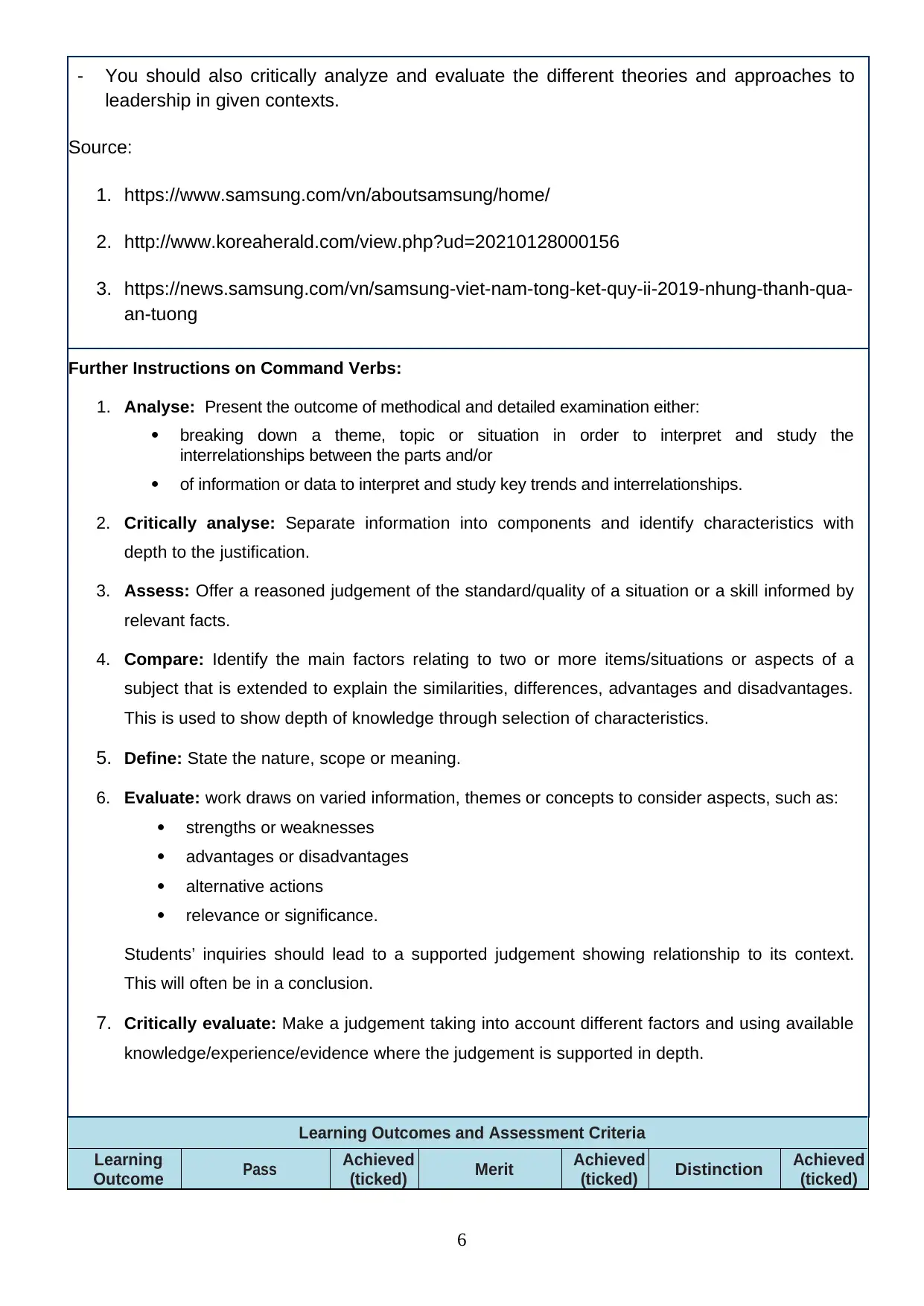
- You should also critically analyze and evaluate the different theories and approaches to
leadership in given contexts.
Source:
1. https://www.samsung.com/vn/aboutsamsung/home/
2. http://www.koreaherald.com/view.php?ud=20210128000156
3. https://news.samsung.com/vn/samsung-viet-nam-tong-ket-quy-ii-2019-nhung-thanh-qua-
an-tuong
Further Instructions on Command Verbs:
1. Analyse: Present the outcome of methodical and detailed examination either:
breaking down a theme, topic or situation in order to interpret and study the
interrelationships between the parts and/or
of information or data to interpret and study key trends and interrelationships.
2. Critically analyse: Separate information into components and identify characteristics with
depth to the justification.
3. Assess: Offer a reasoned judgement of the standard/quality of a situation or a skill informed by
relevant facts.
4. Compare: Identify the main factors relating to two or more items/situations or aspects of a
subject that is extended to explain the similarities, differences, advantages and disadvantages.
This is used to show depth of knowledge through selection of characteristics.
5. Define: State the nature, scope or meaning.
6. Evaluate: work draws on varied information, themes or concepts to consider aspects, such as:
strengths or weaknesses
advantages or disadvantages
alternative actions
relevance or significance.
Students’ inquiries should lead to a supported judgement showing relationship to its context.
This will often be in a conclusion.
7. Critically evaluate: Make a judgement taking into account different factors and using available
knowledge/experience/evidence where the judgement is supported in depth.
Learning Outcomes and Assessment Criteria
Learning
Outcome Pass Achieved
(ticked) Merit Achieved
(ticked) Distinction Achieved
(ticked)
6
leadership in given contexts.
Source:
1. https://www.samsung.com/vn/aboutsamsung/home/
2. http://www.koreaherald.com/view.php?ud=20210128000156
3. https://news.samsung.com/vn/samsung-viet-nam-tong-ket-quy-ii-2019-nhung-thanh-qua-
an-tuong
Further Instructions on Command Verbs:
1. Analyse: Present the outcome of methodical and detailed examination either:
breaking down a theme, topic or situation in order to interpret and study the
interrelationships between the parts and/or
of information or data to interpret and study key trends and interrelationships.
2. Critically analyse: Separate information into components and identify characteristics with
depth to the justification.
3. Assess: Offer a reasoned judgement of the standard/quality of a situation or a skill informed by
relevant facts.
4. Compare: Identify the main factors relating to two or more items/situations or aspects of a
subject that is extended to explain the similarities, differences, advantages and disadvantages.
This is used to show depth of knowledge through selection of characteristics.
5. Define: State the nature, scope or meaning.
6. Evaluate: work draws on varied information, themes or concepts to consider aspects, such as:
strengths or weaknesses
advantages or disadvantages
alternative actions
relevance or significance.
Students’ inquiries should lead to a supported judgement showing relationship to its context.
This will often be in a conclusion.
7. Critically evaluate: Make a judgement taking into account different factors and using available
knowledge/experience/evidence where the judgement is supported in depth.
Learning Outcomes and Assessment Criteria
Learning
Outcome Pass Achieved
(ticked) Merit Achieved
(ticked) Distinction Achieved
(ticked)
6
⊘ This is a preview!⊘
Do you want full access?
Subscribe today to unlock all pages.

Trusted by 1+ million students worldwide
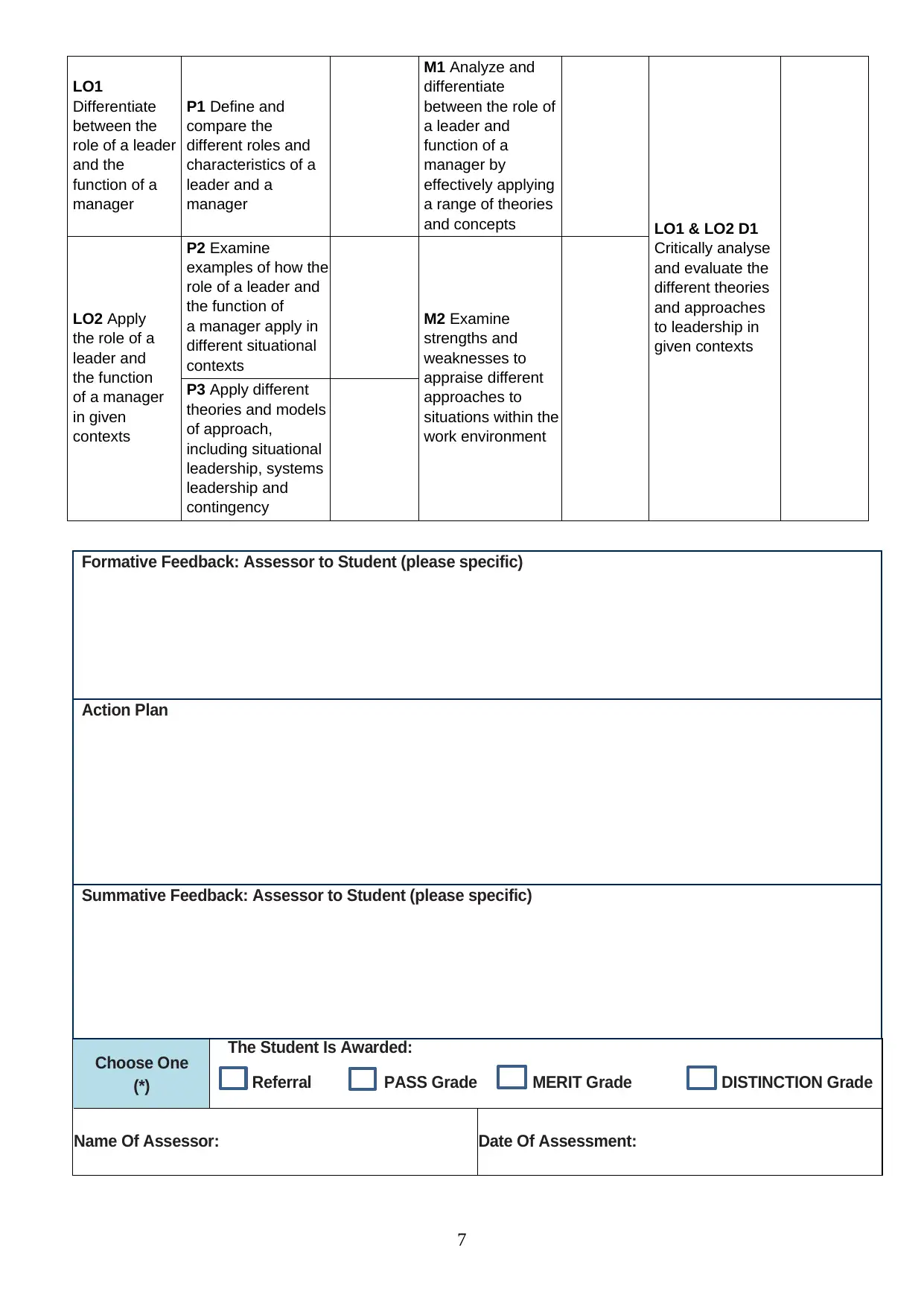
LO1
Differentiate
between the
role of a leader
and the
function of a
manager
P1 Define and
compare the
different roles and
characteristics of a
leader and a
manager
M1 Analyze and
differentiate
between the role of
a leader and
function of a
manager by
effectively applying
a range of theories
and concepts LO1 & LO2 D1
Critically analyse
and evaluate the
different theories
and approaches
to leadership in
given contexts
LO2 Apply
the role of a
leader and
the function
of a manager
in given
contexts
P2 Examine
examples of how the
role of a leader and
the function of
a manager apply in
different situational
contexts
M2 Examine
strengths and
weaknesses to
appraise different
approaches to
situations within the
work environment
P3 Apply different
theories and models
of approach,
including situational
leadership, systems
leadership and
contingency
Formative Feedback: Assessor to Student (please specific)
Action Plan
Summative Feedback: Assessor to Student (please specific)
Choose One
(*)
The Student Is Awarded:
Referral PASS Grade MERIT Grade DISTINCTION Grade
Name Of Assessor: Date Of Assessment:
7
Differentiate
between the
role of a leader
and the
function of a
manager
P1 Define and
compare the
different roles and
characteristics of a
leader and a
manager
M1 Analyze and
differentiate
between the role of
a leader and
function of a
manager by
effectively applying
a range of theories
and concepts LO1 & LO2 D1
Critically analyse
and evaluate the
different theories
and approaches
to leadership in
given contexts
LO2 Apply
the role of a
leader and
the function
of a manager
in given
contexts
P2 Examine
examples of how the
role of a leader and
the function of
a manager apply in
different situational
contexts
M2 Examine
strengths and
weaknesses to
appraise different
approaches to
situations within the
work environment
P3 Apply different
theories and models
of approach,
including situational
leadership, systems
leadership and
contingency
Formative Feedback: Assessor to Student (please specific)
Action Plan
Summative Feedback: Assessor to Student (please specific)
Choose One
(*)
The Student Is Awarded:
Referral PASS Grade MERIT Grade DISTINCTION Grade
Name Of Assessor: Date Of Assessment:
7
Paraphrase This Document
Need a fresh take? Get an instant paraphrase of this document with our AI Paraphraser
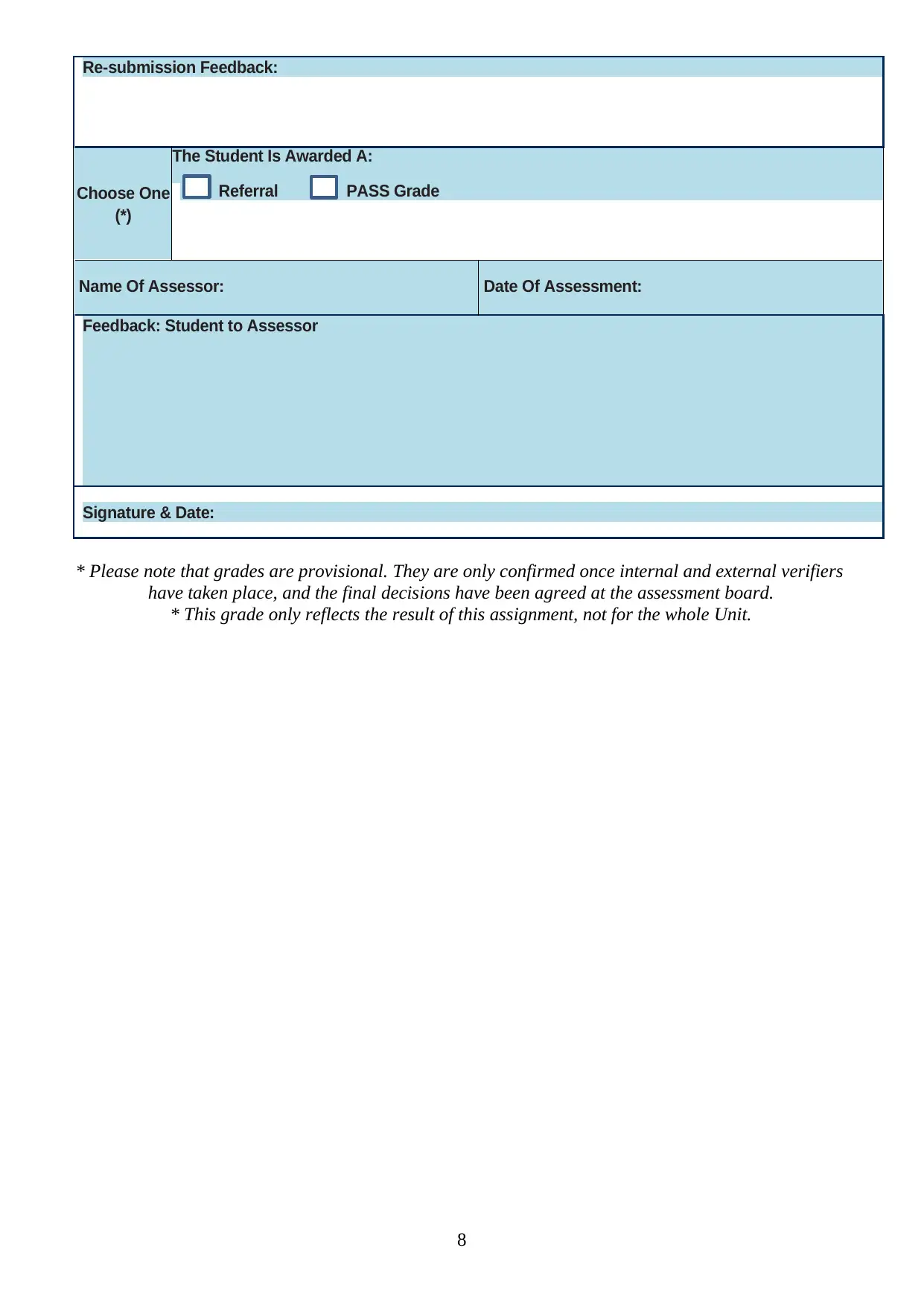
Re-submission Feedback:
Choose One
(*)
The Student Is Awarded A:
Referral PASS Grade
Name Of Assessor: Date Of Assessment:
Feedback: Student to Assessor
Signature & Date:
* Please note that grades are provisional. They are only confirmed once internal and external verifiers
have taken place, and the final decisions have been agreed at the assessment board.
* This grade only reflects the result of this assignment, not for the whole Unit.
8
Choose One
(*)
The Student Is Awarded A:
Referral PASS Grade
Name Of Assessor: Date Of Assessment:
Feedback: Student to Assessor
Signature & Date:
* Please note that grades are provisional. They are only confirmed once internal and external verifiers
have taken place, and the final decisions have been agreed at the assessment board.
* This grade only reflects the result of this assignment, not for the whole Unit.
8
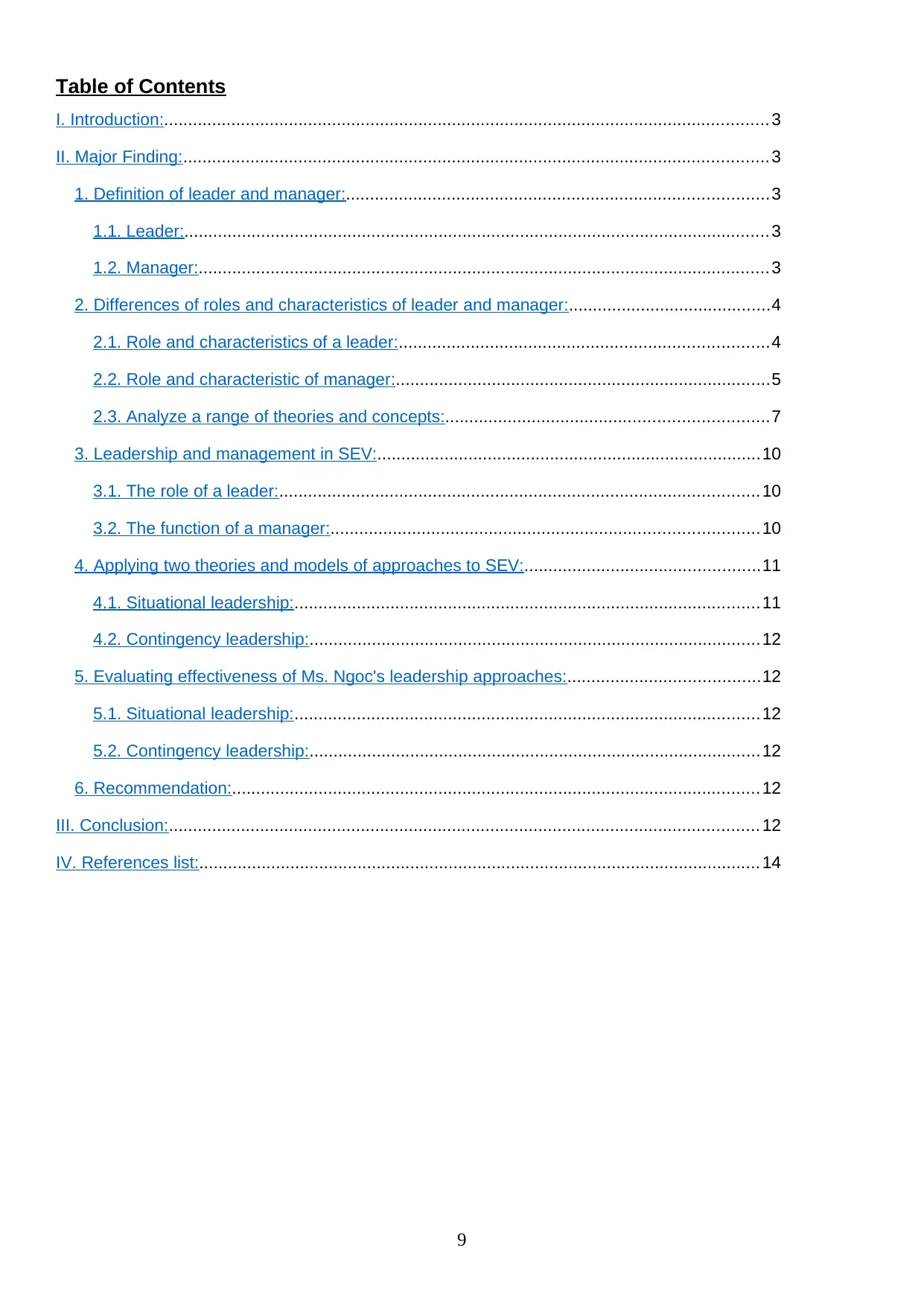
Table of Contents
I. Introduction:.............................................................................................................................. 3
II. Major Finding:.......................................................................................................................... 3
1. Definition of leader and manager:........................................................................................3
1.1. Leader:.......................................................................................................................... 3
1.2. Manager:....................................................................................................................... 3
2. Differences of roles and characteristics of leader and manager:..........................................4
2.1. Role and characteristics of a leader:.............................................................................4
2.2. Role and characteristic of manager:..............................................................................5
2.3. Analyze a range of theories and concepts:...................................................................7
3. Leadership and management in SEV:................................................................................10
3.1. The role of a leader:....................................................................................................10
3.2. The function of a manager:.........................................................................................10
4. Applying two theories and models of approaches to SEV:.................................................11
4.1. Situational leadership:.................................................................................................11
4.2. Contingency leadership:..............................................................................................12
5. Evaluating effectiveness of Ms. Ngoc's leadership approaches:........................................12
5.1. Situational leadership:.................................................................................................12
5.2. Contingency leadership:..............................................................................................12
6. Recommendation:.............................................................................................................. 12
III. Conclusion:........................................................................................................................... 12
IV. References list:..................................................................................................................... 14
9
I. Introduction:.............................................................................................................................. 3
II. Major Finding:.......................................................................................................................... 3
1. Definition of leader and manager:........................................................................................3
1.1. Leader:.......................................................................................................................... 3
1.2. Manager:....................................................................................................................... 3
2. Differences of roles and characteristics of leader and manager:..........................................4
2.1. Role and characteristics of a leader:.............................................................................4
2.2. Role and characteristic of manager:..............................................................................5
2.3. Analyze a range of theories and concepts:...................................................................7
3. Leadership and management in SEV:................................................................................10
3.1. The role of a leader:....................................................................................................10
3.2. The function of a manager:.........................................................................................10
4. Applying two theories and models of approaches to SEV:.................................................11
4.1. Situational leadership:.................................................................................................11
4.2. Contingency leadership:..............................................................................................12
5. Evaluating effectiveness of Ms. Ngoc's leadership approaches:........................................12
5.1. Situational leadership:.................................................................................................12
5.2. Contingency leadership:..............................................................................................12
6. Recommendation:.............................................................................................................. 12
III. Conclusion:........................................................................................................................... 12
IV. References list:..................................................................................................................... 14
9
⊘ This is a preview!⊘
Do you want full access?
Subscribe today to unlock all pages.

Trusted by 1+ million students worldwide
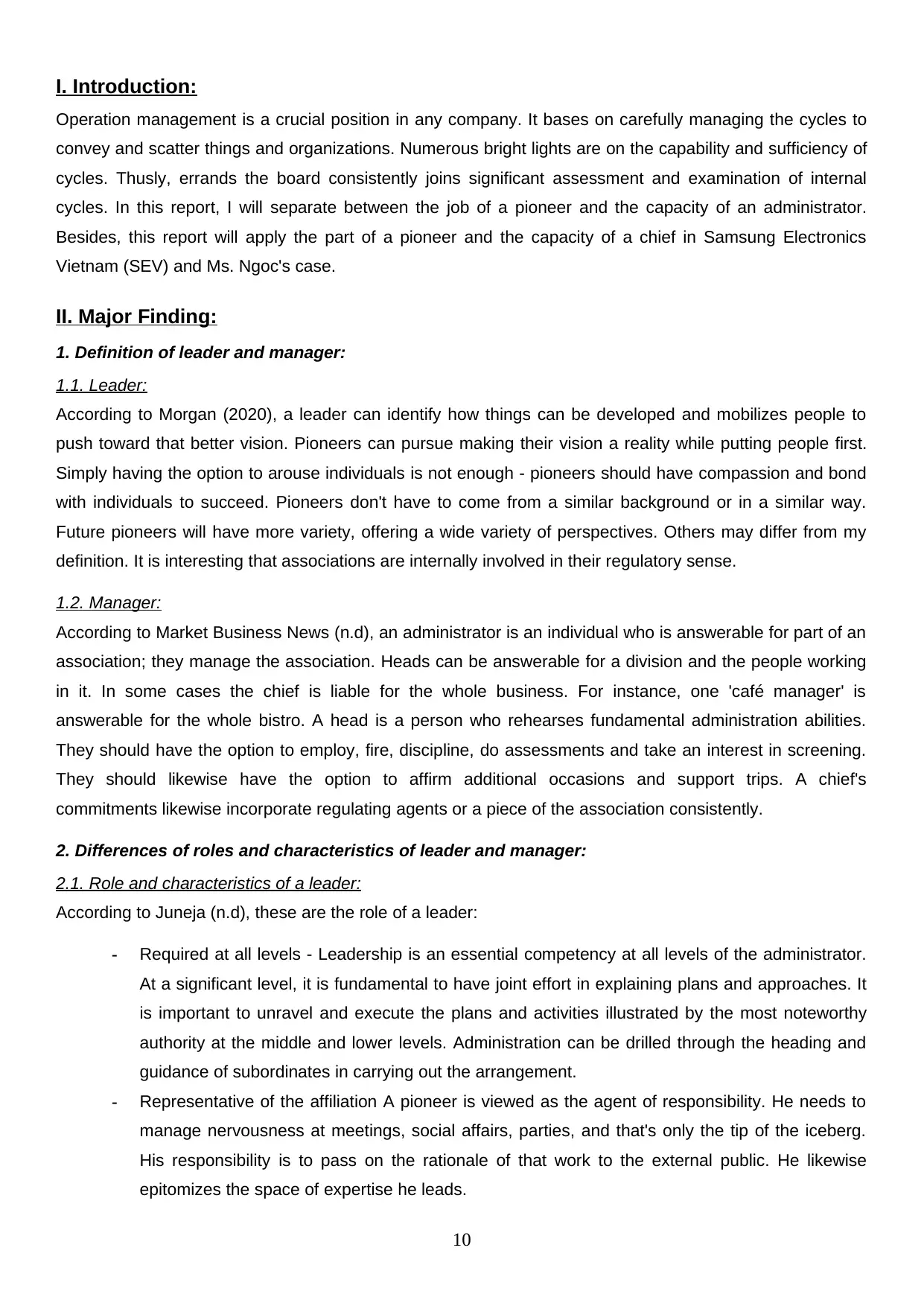
I. Introduction:
Operation management is a crucial position in any company. It bases on carefully managing the cycles to
convey and scatter things and organizations. Numerous bright lights are on the capability and sufficiency of
cycles. Thusly, errands the board consistently joins significant assessment and examination of internal
cycles. In this report, I will separate between the job of a pioneer and the capacity of an administrator.
Besides, this report will apply the part of a pioneer and the capacity of a chief in Samsung Electronics
Vietnam (SEV) and Ms. Ngoc's case.
II. Major Finding:
1. Definition of leader and manager:
1.1. Leader:
According to Morgan (2020), a leader can identify how things can be developed and mobilizes people to
push toward that better vision. Pioneers can pursue making their vision a reality while putting people first.
Simply having the option to arouse individuals is not enough - pioneers should have compassion and bond
with individuals to succeed. Pioneers don't have to come from a similar background or in a similar way.
Future pioneers will have more variety, offering a wide variety of perspectives. Others may differ from my
definition. It is interesting that associations are internally involved in their regulatory sense.
1.2. Manager:
According to Market Business News (n.d), an administrator is an individual who is answerable for part of an
association; they manage the association. Heads can be answerable for a division and the people working
in it. In some cases the chief is liable for the whole business. For instance, one 'café manager' is
answerable for the whole bistro. A head is a person who rehearses fundamental administration abilities.
They should have the option to employ, fire, discipline, do assessments and take an interest in screening.
They should likewise have the option to affirm additional occasions and support trips. A chief's
commitments likewise incorporate regulating agents or a piece of the association consistently.
2. Differences of roles and characteristics of leader and manager:
2.1. Role and characteristics of a leader:
According to Juneja (n.d), these are the role of a leader:
- Required at all levels - Leadership is an essential competency at all levels of the administrator.
At a significant level, it is fundamental to have joint effort in explaining plans and approaches. It
is important to unravel and execute the plans and activities illustrated by the most noteworthy
authority at the middle and lower levels. Administration can be drilled through the heading and
guidance of subordinates in carrying out the arrangement.
- Representative of the affiliation A pioneer is viewed as the agent of responsibility. He needs to
manage nervousness at meetings, social affairs, parties, and that's only the tip of the iceberg.
His responsibility is to pass on the rationale of that work to the external public. He likewise
epitomizes the space of expertise he leads.
10
Operation management is a crucial position in any company. It bases on carefully managing the cycles to
convey and scatter things and organizations. Numerous bright lights are on the capability and sufficiency of
cycles. Thusly, errands the board consistently joins significant assessment and examination of internal
cycles. In this report, I will separate between the job of a pioneer and the capacity of an administrator.
Besides, this report will apply the part of a pioneer and the capacity of a chief in Samsung Electronics
Vietnam (SEV) and Ms. Ngoc's case.
II. Major Finding:
1. Definition of leader and manager:
1.1. Leader:
According to Morgan (2020), a leader can identify how things can be developed and mobilizes people to
push toward that better vision. Pioneers can pursue making their vision a reality while putting people first.
Simply having the option to arouse individuals is not enough - pioneers should have compassion and bond
with individuals to succeed. Pioneers don't have to come from a similar background or in a similar way.
Future pioneers will have more variety, offering a wide variety of perspectives. Others may differ from my
definition. It is interesting that associations are internally involved in their regulatory sense.
1.2. Manager:
According to Market Business News (n.d), an administrator is an individual who is answerable for part of an
association; they manage the association. Heads can be answerable for a division and the people working
in it. In some cases the chief is liable for the whole business. For instance, one 'café manager' is
answerable for the whole bistro. A head is a person who rehearses fundamental administration abilities.
They should have the option to employ, fire, discipline, do assessments and take an interest in screening.
They should likewise have the option to affirm additional occasions and support trips. A chief's
commitments likewise incorporate regulating agents or a piece of the association consistently.
2. Differences of roles and characteristics of leader and manager:
2.1. Role and characteristics of a leader:
According to Juneja (n.d), these are the role of a leader:
- Required at all levels - Leadership is an essential competency at all levels of the administrator.
At a significant level, it is fundamental to have joint effort in explaining plans and approaches. It
is important to unravel and execute the plans and activities illustrated by the most noteworthy
authority at the middle and lower levels. Administration can be drilled through the heading and
guidance of subordinates in carrying out the arrangement.
- Representative of the affiliation A pioneer is viewed as the agent of responsibility. He needs to
manage nervousness at meetings, social affairs, parties, and that's only the tip of the iceberg.
His responsibility is to pass on the rationale of that work to the external public. He likewise
epitomizes the space of expertise he leads.
10
Paraphrase This Document
Need a fresh take? Get an instant paraphrase of this document with our AI Paraphraser
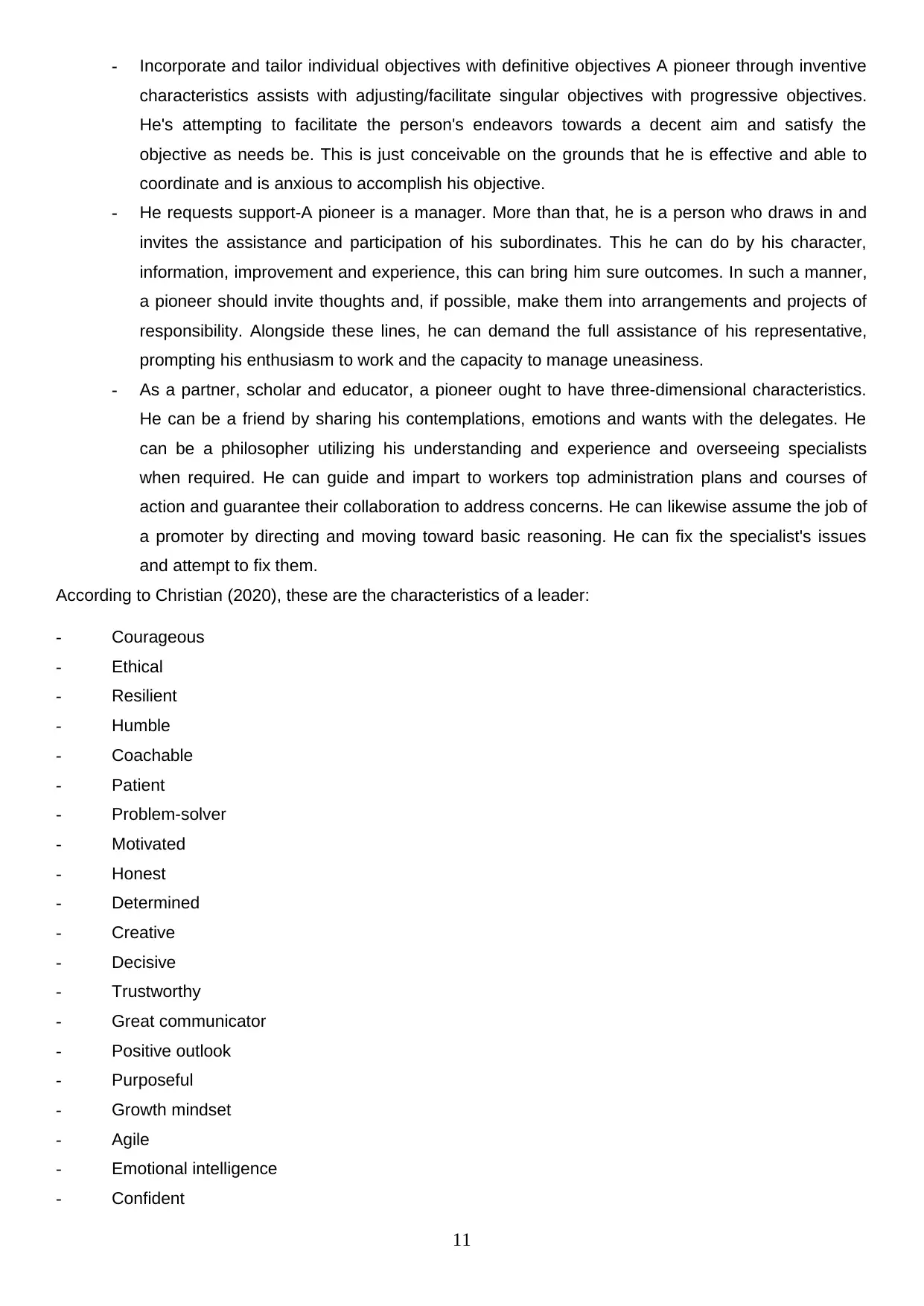
- Incorporate and tailor individual objectives with definitive objectives A pioneer through inventive
characteristics assists with adjusting/facilitate singular objectives with progressive objectives.
He's attempting to facilitate the person's endeavors towards a decent aim and satisfy the
objective as needs be. This is just conceivable on the grounds that he is effective and able to
coordinate and is anxious to accomplish his objective.
- He requests support-A pioneer is a manager. More than that, he is a person who draws in and
invites the assistance and participation of his subordinates. This he can do by his character,
information, improvement and experience, this can bring him sure outcomes. In such a manner,
a pioneer should invite thoughts and, if possible, make them into arrangements and projects of
responsibility. Alongside these lines, he can demand the full assistance of his representative,
prompting his enthusiasm to work and the capacity to manage uneasiness.
- As a partner, scholar and educator, a pioneer ought to have three-dimensional characteristics.
He can be a friend by sharing his contemplations, emotions and wants with the delegates. He
can be a philosopher utilizing his understanding and experience and overseeing specialists
when required. He can guide and impart to workers top administration plans and courses of
action and guarantee their collaboration to address concerns. He can likewise assume the job of
a promoter by directing and moving toward basic reasoning. He can fix the specialist's issues
and attempt to fix them.
According to Christian (2020), these are the characteristics of a leader:
- Courageous
- Ethical
- Resilient
- Humble
- Coachable
- Patient
- Problem-solver
- Motivated
- Honest
- Determined
- Creative
- Decisive
- Trustworthy
- Great communicator
- Positive outlook
- Purposeful
- Growth mindset
- Agile
- Emotional intelligence
- Confident
11
characteristics assists with adjusting/facilitate singular objectives with progressive objectives.
He's attempting to facilitate the person's endeavors towards a decent aim and satisfy the
objective as needs be. This is just conceivable on the grounds that he is effective and able to
coordinate and is anxious to accomplish his objective.
- He requests support-A pioneer is a manager. More than that, he is a person who draws in and
invites the assistance and participation of his subordinates. This he can do by his character,
information, improvement and experience, this can bring him sure outcomes. In such a manner,
a pioneer should invite thoughts and, if possible, make them into arrangements and projects of
responsibility. Alongside these lines, he can demand the full assistance of his representative,
prompting his enthusiasm to work and the capacity to manage uneasiness.
- As a partner, scholar and educator, a pioneer ought to have three-dimensional characteristics.
He can be a friend by sharing his contemplations, emotions and wants with the delegates. He
can be a philosopher utilizing his understanding and experience and overseeing specialists
when required. He can guide and impart to workers top administration plans and courses of
action and guarantee their collaboration to address concerns. He can likewise assume the job of
a promoter by directing and moving toward basic reasoning. He can fix the specialist's issues
and attempt to fix them.
According to Christian (2020), these are the characteristics of a leader:
- Courageous
- Ethical
- Resilient
- Humble
- Coachable
- Patient
- Problem-solver
- Motivated
- Honest
- Determined
- Creative
- Decisive
- Trustworthy
- Great communicator
- Positive outlook
- Purposeful
- Growth mindset
- Agile
- Emotional intelligence
- Confident
11
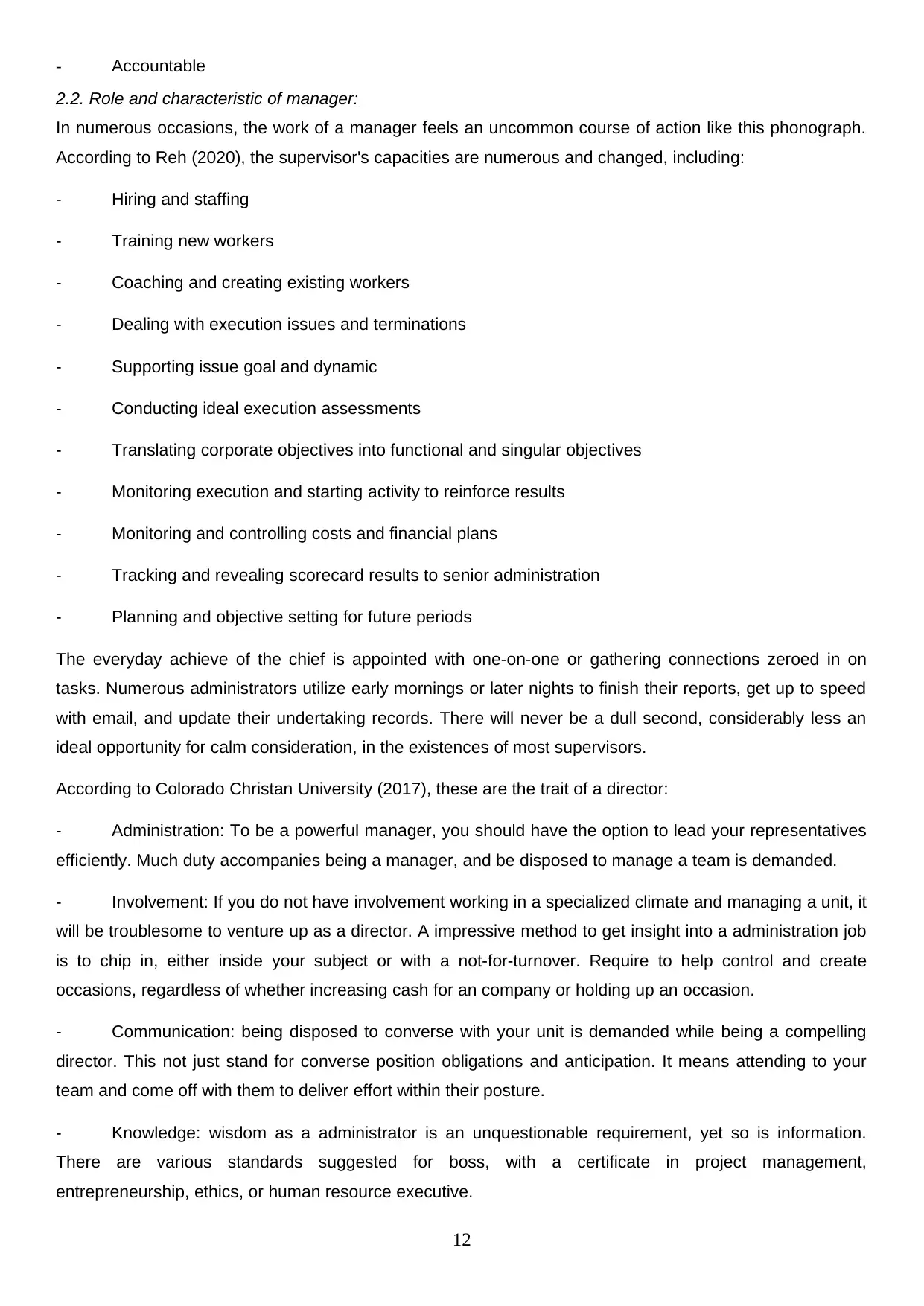
- Accountable
2.2. Role and characteristic of manager:
In numerous occasions, the work of a manager feels an uncommon course of action like this phonograph.
According to Reh (2020), the supervisor's capacities are numerous and changed, including:
- Hiring and staffing
- Training new workers
- Coaching and creating existing workers
- Dealing with execution issues and terminations
- Supporting issue goal and dynamic
- Conducting ideal execution assessments
- Translating corporate objectives into functional and singular objectives
- Monitoring execution and starting activity to reinforce results
- Monitoring and controlling costs and financial plans
- Tracking and revealing scorecard results to senior administration
- Planning and objective setting for future periods
The everyday achieve of the chief is appointed with one-on-one or gathering connections zeroed in on
tasks. Numerous administrators utilize early mornings or later nights to finish their reports, get up to speed
with email, and update their undertaking records. There will never be a dull second, considerably less an
ideal opportunity for calm consideration, in the existences of most supervisors.
According to Colorado Christan University (2017), these are the trait of a director:
- Administration: To be a powerful manager, you should have the option to lead your representatives
efficiently. Much duty accompanies being a manager, and be disposed to manage a team is demanded.
- Involvement: If you do not have involvement working in a specialized climate and managing a unit, it
will be troublesome to venture up as a director. A impressive method to get insight into a administration job
is to chip in, either inside your subject or with a not-for-turnover. Require to help control and create
occasions, regardless of whether increasing cash for an company or holding up an occasion.
- Communication: being disposed to converse with your unit is demanded while being a compelling
director. This not just stand for converse position obligations and anticipation. It means attending to your
team and come off with them to deliver effort within their posture.
- Knowledge: wisdom as a administrator is an unquestionable requirement, yet so is information.
There are various standards suggested for boss, with a certificate in project management,
entrepreneurship, ethics, or human resource executive.
12
2.2. Role and characteristic of manager:
In numerous occasions, the work of a manager feels an uncommon course of action like this phonograph.
According to Reh (2020), the supervisor's capacities are numerous and changed, including:
- Hiring and staffing
- Training new workers
- Coaching and creating existing workers
- Dealing with execution issues and terminations
- Supporting issue goal and dynamic
- Conducting ideal execution assessments
- Translating corporate objectives into functional and singular objectives
- Monitoring execution and starting activity to reinforce results
- Monitoring and controlling costs and financial plans
- Tracking and revealing scorecard results to senior administration
- Planning and objective setting for future periods
The everyday achieve of the chief is appointed with one-on-one or gathering connections zeroed in on
tasks. Numerous administrators utilize early mornings or later nights to finish their reports, get up to speed
with email, and update their undertaking records. There will never be a dull second, considerably less an
ideal opportunity for calm consideration, in the existences of most supervisors.
According to Colorado Christan University (2017), these are the trait of a director:
- Administration: To be a powerful manager, you should have the option to lead your representatives
efficiently. Much duty accompanies being a manager, and be disposed to manage a team is demanded.
- Involvement: If you do not have involvement working in a specialized climate and managing a unit, it
will be troublesome to venture up as a director. A impressive method to get insight into a administration job
is to chip in, either inside your subject or with a not-for-turnover. Require to help control and create
occasions, regardless of whether increasing cash for an company or holding up an occasion.
- Communication: being disposed to converse with your unit is demanded while being a compelling
director. This not just stand for converse position obligations and anticipation. It means attending to your
team and come off with them to deliver effort within their posture.
- Knowledge: wisdom as a administrator is an unquestionable requirement, yet so is information.
There are various standards suggested for boss, with a certificate in project management,
entrepreneurship, ethics, or human resource executive.
12
⊘ This is a preview!⊘
Do you want full access?
Subscribe today to unlock all pages.

Trusted by 1+ million students worldwide
1 out of 19
Related Documents
Your All-in-One AI-Powered Toolkit for Academic Success.
+13062052269
info@desklib.com
Available 24*7 on WhatsApp / Email
![[object Object]](/_next/static/media/star-bottom.7253800d.svg)
Unlock your academic potential
Copyright © 2020–2025 A2Z Services. All Rights Reserved. Developed and managed by ZUCOL.





